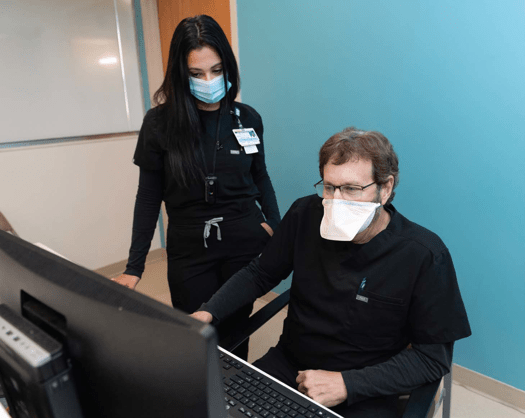The Telehealth Emergency Department at Clara Maass Medical Center allows patients to have a video call with a board-certified emergency care provider.
When do you need to go to the Emergency Department (ED)? For many people, the answer is far from clear.
That’s why Clara Maass Medical Center (CMMC) has created the Telehealth Emergency Department, a service that allows patients to be seen virtually by a board-certified emergency care provider through a scan of a QR code or a click on a link.
Just as in a real-life visit to the ED, a telehealth patient will be greeted, assessed and swiftly connected with a health care provider.

“This isn’t a phone call,” emphasizes John Fontanetta, MD, Chair of Emergency Medicine at CMMC. “It’s a full telehealth service with video. The provider gets to look at somebody’s laceration or injured wrist, look into the patient’s eyes and make an informed recommendation.”
The program, which is being piloted for the entire RWJBarnabas Health system, was created based on the staff’s assessment of community needs.
“This is a way for our community to have easy access to the ED,” says Donna Maria DeVita, BSN, RN, Director of the ED.
“If they do need to come in, often they’re going to be able to see the same provider they first connected with,” she explains. “Being able to do that is very important to many people.”
A Safety Net
Though open to anyone in the CMMC service area, the Telehealth Emergency Department is particularly useful for people in specific situations, including:
- Patients who use the ED frequently: This group includes people with a chronic illness, or those who use medical devices and have questions about them. “At Clara Maass, we have a great relationship with community members, and we’ve built a lot of trust,” DeVita says. “When these patients come in, we know them, and know their history and what they need.”
- Patients who question whether they need to go to the ED: “Sometimes people are a little embarrassed, or wondering if they’re wasting people’s time, and having this service reassures them,” says Dr. Fontanetta. “We may validate their need to come to the ED, and if they do, we will have all their information in the computer and be ready for them. However, it’s not uncommon for us to be able to solve a patient’s problem via a telehealth assessment without their coming in.”
- Emergency Medical Services personnel: The new Telehealth Emergency Department may be a literal lifesaver if a patient on an emergency call needs further care but is resistant to going to the hospital, or has questions the emergency technicians can’t answer.
“The ED is a safety net for the community,” Dr. Fontanetta says. “People don’t only get sick during weekdays from nine to five. We’re here 24 hours a day, seven days a week to provide services, and now we can offer those services in a way that patients can access from anywhere.”
To connect with the Telehealth Emergency Department from your tablet, smartphone or computer, visit RWJBH.doxy.me/cmmced.
